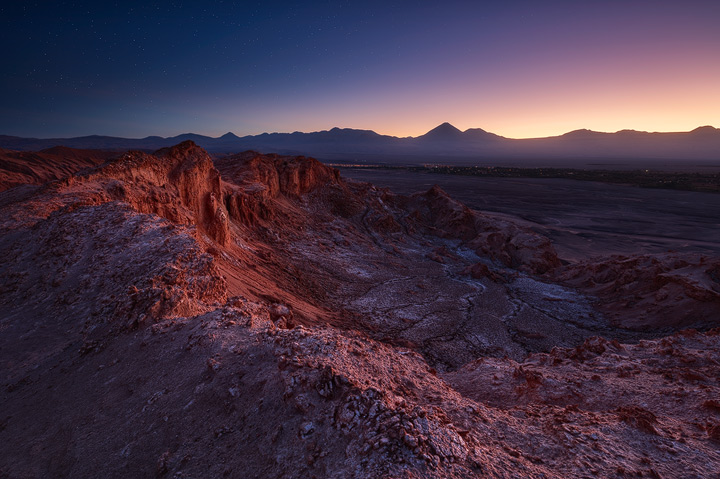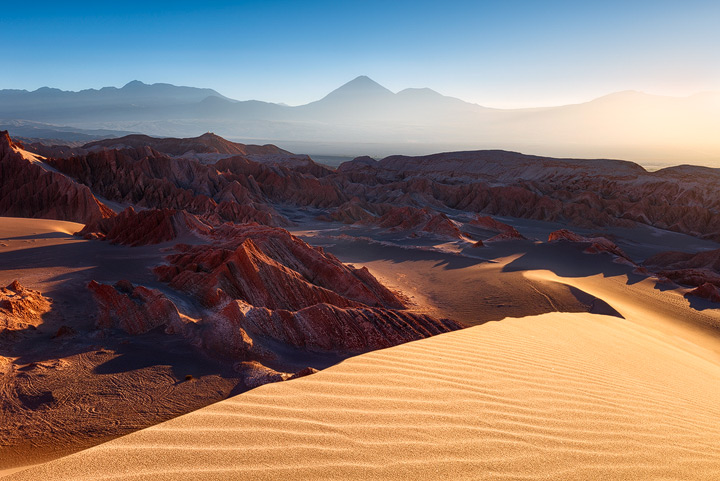Blog - Atacama
Photography Location Guides | by Michael Breitung
After four days in the mountains of Bolivia, we crossed the border at Hito Cajon and entered the fourth country of our tour around the world, Chile. It struck me how abrupt the change in infrastructure was. The rough dirt roads of Bolivia were transformed into paved roads just a few 100 meters beyond the border. Where before there had been only a few 4×4 Jeeps, there were now buses.
I had already heard about the mass tourism around San Pedro de Atacama, but after the solitude we had enjoyed in Bolivia it was a drastic change. The town was buzzing with people, many of them backpackers on their way through South America.
Despite the masses and the much higher prices though, it was great to have a selection of restaurants again, a little supermarket and most importantly a shower. Getting around town was also super easy, either by walking or on the bicycles that were included with our accommodation.
I didn’t waste much time and made a first exploratory bike tour up the road to Calama. It ascended to some nice viewpoints, from which I could see the distant Andean Mountains. Some scouting brought me to a particularly interesting location with steep cliffs in the foreground, a crater-like landscape in the middle ground and San Pedro with the Andean Mountains behind in the background.
The next morning the alarm rang two hours before sunrise and for the first time I experienced San Pedro and the surrounding landscape devoid of any people. I enjoyed the bike ride in the fresh morning air and arrived at location in the pre-dawn darkness. As I sat at the viewpoint and waited I was surrounded by total silence – no animal sounds, no wind, no cars. As the raw desert landscape slowly began to emerge from the gloom, it was magical.

San Pedro de Atacama
Equipment: Canon EOS 5DS-R | Canon 16-35mm f/4 IS | Lee 0.6 hard GND + Lee 0.6 soft GND
Exif: f/4,5 + f/9,5 | 16mm | ISO 2000 + ISO 100 | 20s, 3s, 10s multiple exposures blended
When I was back in San Pedro again the town had awoken. The objective for the day besides booking one of the tours to Valle de la Luna for the evening was finding a laundry. Until now it had always been easy to find a cheap laundry option, but in San Pedro there was only one laundry and the price was ridiculous. We would have ended up with around 20 Euros to get all our clothes washed and it would have taken 1,5 days. Plus the woman who ran the laundry was one of the most unfriendly people I had encountered during our time in South America.
Fortunately Carlos, the owner of the Pro Desert Camper Lodge where we were staying, also had laundry service available. It took only 6 hours to get our clothes washed and dried and it was even cheaper.
In the evening we went on one of the tours to Valle de la Luna. For around 10 Euro per person we could select from around 40 tours, which all do exactly the same: Start in San Pedro around 4pm, drive to Valle de La Luna with some viewpoints and then head to Piedra de Coyote for sunset. It was stupid because everywhere we went it was crowded. The next funny fact about the tour: They advertised experiencing the sunset in the desert but we left just with the sun vanishing behind the horizon. So there was no real experience because before sunset they already started to rush us back into the bus. Just as the landscape started to glow we were on our way back to town.
To sum it up, this first tour was nothing more than a scouting trip to get an overview about the different locations. It would have been great to have an own car, but the local car rental didn’t have any cars for the time we were in San Pedro, so it was either tour or bicycle.
The next days I took the bicycle, which was quite a workout in the evening. I had already experienced strong winds in Bolivia and here it was the same. They started picking up in the afternoon, just when I was usually cycling to my sunset locations. One evening the winds were so strong that it took me more than 90 minutes for the 12km to Valle de la Luna. When I arrived there I was exhausted. I didn’t even get a good photo that evening and the ride back was a nightmare because I was constantly overtaken in the darkness by buses and cars, which were also on their way back to San Pedro.
So the next evening I decided to head to Piedra de Coyote instead. On the drive up there I was mostly shaded from the wind and the way back to town was mostly downhill. This evening was magical. I was up there more than one hour before sunset and I was the only person there. Just 30 minutes before sunset it began to fill up with hundreds of people. And then, 10 minutes after sunset I was alone again.
I photographed the landscape exclusively with my 70-200 mm lens that evening, trying to get some more detailed views of it. Also with the telephoto lens I didn’t need any clouds in the sky. It was a productive evening and I like the results very much. There’s just so much structure and cracks, intricately shaped mountains and then there is salt evaporating from the earth, which looks a bit like frost or snow.

Moon Valley
Equipment: Canon EOS 5DS-R | Canon 70-200mm f/4 IS
Exif: f/11 | 144mm | ISO 100 | 1/8s

Dark Side of the Moon
Equipment: Canon EOS 5DS-R | Canon 70-200mm f/4 IS
Exif: f/11 | 150mm | ISO 100 | 1/8s

Red Planet
Equipment: Canon EOS 5DS-R | Canon 70-200mm f/4 IS
Exif: f/11 | 97mm | ISO 100 | 6s
A visit to the Tatio Geysers unfortunately wasn’t feasible by bike. So we had to do another tour. But this time we did a little bit more research to find a tour, which didn’t just do it like all the others. We found Cosmo Andino, one of maybe 3 agencies, who actually try to avoid the masses by adjusting their itineraries accordingly.
At Tatio itself this was not possible though. In the morning there are maybe 50 buses full of tourists who wanted to take their selfies. Some time ago one of them had fallen into a Geyser and died because she had gotten too close for such a photo. On our visit the areas where one could walk were clearly marked and there were little rings of stones around the Geysers. Thus the whole area didn’t feel very raw and natural anymore. But again the tele lens helped me to get at least a few decent photos.
On the way back to San Pedro Cosmo Andino avoided a little Andean village, which got swarmed by the other tours. Instead we went exploring a canyon full of huge cacti. It was a nice nature experience but with the sun high in the sky it was impossible to take a good photo.

Tatio
Equipment: Canon EOS 5DS-R | Canon 70-200mm f/4 IS
Exif: f/11 | 81mm | ISO 100 | 1/250s
For the last day in San Pedro I had one more photo on my list. During my previous bicycle tours I had visited Valle de la Muerte, which is sometimes also called Valle de Marte. I find the latter more fitting, since this place really looks like one would imagine Mars. There’s a huge dune, which around noon is used for sand boarding.
But in the morning nobody was there. There’s a gate, which is closed in the morning. But with my bicycle I could easily duck under it. Since I had payed the entrance during my scouting tour already I didn’t feel too bad about it. With all the tours and entrance fees of the previous days we had left enough money in San Pedro.
As I drove the few kilometers through the canyon towards the dune it felt a bit spooky. It was still well before sunrise and I could just see what my torch illuminated. As I arrived at the dune the real workout began. I didn’t want to have footprints in my photo so instead of the easy path along the ridge I climbed the steep slope behind my desired viewpoint. It took me more than 15 minutes to reach the top, which I didn’t see until I was a few meters below the crest.
The early rise and sweat were well worth it. The view along the ridge towards Licancabur in the distance is in my opinion the best view around San Pedro. I didn’t even resent having no clouds in the sky yet again. For this view the blue sky provided the perfect backdrop and I enjoyed every minute as the sun slowly crept over the mountains.

Welcome to Mars : Prints Available
Equipment: Canon EOS 5DS-R | Canon 16-35mm f/4 IS | Lee 0.6 soft GND + Lee 0.6 hard GND
Exif: f/9,5 – f/16 | 35mm | ISO 100 | 1/180s – 1/10s multiple exposures blended for focus stacking and dynamic range
After six days our time in San Pedro was over. Despite the crowds we had a great time, especially because of our beautiful accommodation. It was like a little oasis where we got regular visits from some of the friendly dogs in town. For me it was a good place to get the batteries recharged, which was much needed after the previous weeks of travel through South America.
To draw a balance, I have to admit that it wasn’t always easy. I was glad I had planned most of the trip prior to the start of our world tour, because it took away some of the pressure during traveling. South America might be great for backpackers, who don’t travel with camera equipment of a few thousand euros. But having a backpack full of camera gear results in the constant need to be aware of the surroundings, the constant question, if it is safer to leave it in the hotel or to take it along. Then there are the strange opening hours of many places, which often don’t include sunrise or sunset. This makes photography a lot harder.
But it was also a great experience. We were able to practice our Spanish, we met many friendly and helpful people. Especially Ecuador stood out in this regard. Also the landscapes we saw were something completely different to what we had encountered during our previous travels. We visited the jungle and just a few days later drove through the desert like landscape of Bolivia. Never staying more than six days in one area made it a very diversified tour. It was sometimes exhausting but the constant change was also what made our time in South America so interesting.

Santiago
Equipment: Canon EOS 5DS-R | Canon 16-35mm f/4 IS | Hoya HD Polarizer + Lee 0.6 hard GND
Exif: f/11 | 20mm | ISO 100 | 4s – 61s multiple exposures blended
Left now were two 12 hour bus rides down to Santiago, where we met up with my niece, who was studying there at the time. The two days in Santiago were a great finish to the first major part of our journey. Our next stop was Australia.

